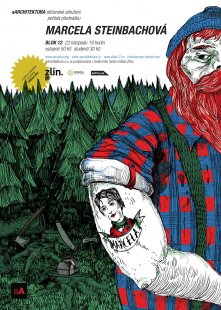
<aArchitektura> introduces: Marcela Steinbachová</aArchitektura>
Thursday, November 22, 2012, from 19:00, BLOCK 12, J. A. Bati 5637, Zlín
Source
aArchitektura o.s.
aArchitektura o.s.
Publisher
Tisková zpráva
16.11.2012 23:00
Tisková zpráva
16.11.2012 23:00
Lectures
Marcela Steinbachová
Skupina
We are pleased to invite authors to lectures who are not strictly focused solely on the profession of architecture but whose activities transcend into the realms of its promotion or other civic activism. Through this activity, space is created for dialogue (not only) about quality Czech and world architecture outside the narrow circle of professionals and architecture students. Marcela Steinbachová is not only an architect but also a founding member of the civic association Kruh, which has been focusing since 2001 on expanding architectural awareness primarily through lectures and discussions, publishing books and anthologies, organizing excursions, and today organizing the popular and well-attended Architecture Day, which involves walks with architects through interesting places in the cities where they live. The inspiration for these activities has come from her experiences during foreign internships in New York, Salzburg, and Vienna.
Marcela Steinbachová graduated from Emil Přikryl's studio at the Academy of Fine Arts in Prague, where she has also been working as an assistant professor since 2007. This educational institution is exceptional in the Czech environment, with graduates from other architectural schools studying here, meeting people studying fine arts, discussing, and collaborating. Collaboration with visual artists has become an important theme for Marcela Steinbachová, often reflected in her architectural work. To date, she has collaborated with Krištof Kintera, Markéta Šafáriková, and graphic designers Helena Šantavá and Adéla Svobodová, for example.
She established her own architectural studio Skupina, which focuses on designing buildings, urbanism, interior design, exhibitions, and small-scale design. They create contemporary and distinctive architectural works with many overlaps. Among realized projects, we highlight the interior solutions for the Komorní scéna Aréna theater in Ostrava, the interiors of a manufacturing and administrative building in Hodonín, and the installation of the permanent exhibition at the Ostrava Museum. Noteworthy reconstructions include, for instance, the Světozor Cinema and the Franz Kafka Center in Prague, created in collaboration with the famous architect Steven Holl. Among unrealized projects, the most interesting is the competition design for Wenceslas Square for the 21st century from 2005. The basic concept returns to the medieval visions of Charles IV. Instead of a square with trees, an open space was proposed that connects the square from facade to facade. Below this level, underground metro vestibules connect to a large commercial and cultural passage with its own supply chain. By day, these spaces are illuminated by a glass block surface from the square; at night, conversely, the square is illuminated by the commercial passage.
Please accept our invitation to the penultimate meeting of this year, which will take place on November 22, 2012, at 19:00 at Café Blok 12, J.A. Bati 5637, 760 01 in Zlín. More information and online lectures can be followed at www.aarchitektura.cz.
More information about Marcela Steinbachová's work and activities is available at www.skupina.org or www.kruh.info and www.denarchitektury.cz.
Marcela Steinbachová graduated from Emil Přikryl's studio at the Academy of Fine Arts in Prague, where she has also been working as an assistant professor since 2007. This educational institution is exceptional in the Czech environment, with graduates from other architectural schools studying here, meeting people studying fine arts, discussing, and collaborating. Collaboration with visual artists has become an important theme for Marcela Steinbachová, often reflected in her architectural work. To date, she has collaborated with Krištof Kintera, Markéta Šafáriková, and graphic designers Helena Šantavá and Adéla Svobodová, for example.
She established her own architectural studio Skupina, which focuses on designing buildings, urbanism, interior design, exhibitions, and small-scale design. They create contemporary and distinctive architectural works with many overlaps. Among realized projects, we highlight the interior solutions for the Komorní scéna Aréna theater in Ostrava, the interiors of a manufacturing and administrative building in Hodonín, and the installation of the permanent exhibition at the Ostrava Museum. Noteworthy reconstructions include, for instance, the Světozor Cinema and the Franz Kafka Center in Prague, created in collaboration with the famous architect Steven Holl. Among unrealized projects, the most interesting is the competition design for Wenceslas Square for the 21st century from 2005. The basic concept returns to the medieval visions of Charles IV. Instead of a square with trees, an open space was proposed that connects the square from facade to facade. Below this level, underground metro vestibules connect to a large commercial and cultural passage with its own supply chain. By day, these spaces are illuminated by a glass block surface from the square; at night, conversely, the square is illuminated by the commercial passage.
Please accept our invitation to the penultimate meeting of this year, which will take place on November 22, 2012, at 19:00 at Café Blok 12, J.A. Bati 5637, 760 01 in Zlín. More information and online lectures can be followed at www.aarchitektura.cz.
More information about Marcela Steinbachová's work and activities is available at www.skupina.org or www.kruh.info and www.denarchitektury.cz.
The English translation is powered by AI tool. Switch to Czech to view the original text source.

Related articles
0
13.02.2020 | Marcela Steinbachová: Contexts - lecture at FA CTU
0
13.05.2013 | <aArchitektura> presents: MARTIN HRDINA</aArchitektura>
0
12.10.2012 | <aArchitektura> introduces: Vallo Sadovsky Architects</aArchitektura>
0
17.09.2012 | <aArchitektura uvádí: gutgut</aArchitektura>
0
04.06.2012 | <aArchitektura uvádí: A1Architects</aArchitektura uvádí: A1Architects>Architectura states: A1Architects</aArchitectura>
0
04.05.2012 | <aArchitektura> reports: Marek Štěpán</aArchitektura>
0
05.04.2012 | <aArchitektura> states: Mjölk architects</aArchitektura>











